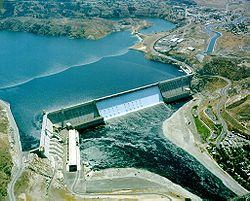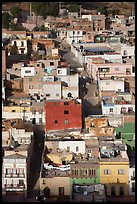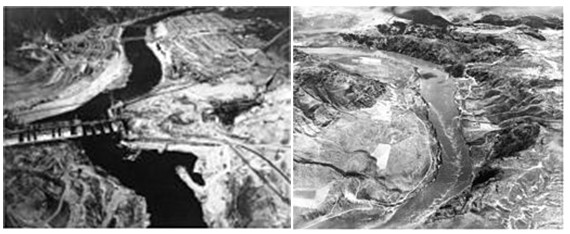Introduction
Environmental planning is when decision making is done to attain development of an area while giving due thought to factors that may include Mother Nature (environment), economic policies and political aspects, governmental policies as well as social aspects and at the same time allowing for a holistic outline to produce viable results that will be of mutual benefit to both the resident communities and nature.
Several issues may affect the construction of a reservoir along the course of a river, with different aspects and interests being brought forth. These may cover a vast array of issues with diverse views and interests. Environmental planning tries to direct these processes not only effectively but also transparently, methodically and in an equitable manner to the advantage of constituents of the affected schemes, presently and in later years.
Among the building blocks of environmental planning in the present day are issues such as regional development, infrastructure systems, natural resources and land use that’s integrated, governance policies, urban development and social and economic development. Integrated environmental planning assessment encompasses among other things land use, wetlands, air pollution, endangered species, noise pollution, transportation, flood zones, coastal zones erosion, housing and visual studies.
Issues on dams and reservoirs
Building dams brings about changes to the region, completely altering the physical characters and this is due to several different factors. A poorly planned dam construction would pose an ecological disaster. This is in regard to the impact of the construction on the environment. A wide scope of personal interpretation has got to be applied when pondering about the environment. These are mainly social, cultural and environmental impacts.
Most planners hardly ever consider the reasons to foresee related impacts. Issues that affect dam constructions could be local, regional, national or international. The erection of dams leads to evident changing of the watercourse and its usual flow. Even so, upstream, a contrasting set of changes is witnessed as the resultant reservoir forms a lake on what was formerly dry ground that was either residential or farmland. Though there are myriads of problems affecting dam construction assessment, not all can be deliberated on seeing as it would be more viable to focus on the most important ones which are environmental and socio-economic impacts.

Impacts of dams
The assorted environmental impacts of dams can be divided and sub-divided into several groups. These range from upstream and downstream impacts, to biological and physical impacts. Climatic changes that refer to the drop in temperatures due to the change of environment caused by the buildup of water play a vital role in determining the impacts on the environment. Stagnation deprives the water of oxygen which in turn affects living organisms in the water like fish. The local communities have a portion of people that thrive on the fishing business and would be rendered jobless and with no means of earning a living.
Stagnation
Stagnation is resultant of silt build-up against the physical structure, which over time piles up to become a load on the structure thus weakening it and posing a grave danger to the inhabitants downstream.
Further issues
However, problems that are faced downstream are treated less seriously because once the interested parties are through with the water upstream, unless, for the necessary parts, they hardly consider side effects on a wider range unlike for upstream. Fisheries and wildlife downstream also get less consideration because they thrive on a livelihood based on the water. Another aspect that is widely overlooked is the fact that the ecosystems get imbalanced because for example, the fish cannot camouflage themselves thus remain vulnerable to predators. Also, the physical altering of the flow of water causes thermal damage downstream for living organisms that thrive in the water.
Another problem that is faced downstream is the continuous discharge of solid waste and wastewater. This raises eyebrows concerning dumping. Health management issues come up as this is raised. This not only affects only the local human community at large, but encompasses the wider range covering a wide part of the inhabitants.
In cases where the migration of fish is involved, the pattern is totally interfered with and thus may lead to extinction of some rare species if it’s not put into consideration. Some species of fish migrate along the river for breeding purposes as they have since time immemorial. When their cycle gets interrupted, they may become extinct.
Socio-economic effects
Other impacts that affect the reservoir environmental planners are among others, socio-economic factors. This involves the use of local labor. For the planning team to achieve their target, they will have to employ locals because without involving the locals the project may experience difficulties that had not been counted on.
The displacement of people has also to be put into consideration when planning on environmental issues. The issue of displacement touches on the local communities so severely, that it involves permanent changes to the lives of the people living within the region. These changes may include resettling into a new place with one having to relocate with their spouses and finding new jobs and new schools for the children which may pose a challenge especially for the people who move from rural to urban areas.
The planning challenges
There are numerous challenges encompassed in the planning and implementation of a dam construction this size. Since the “High Dam” is located just on the outskirts of a town (Milo) along a river passing near a game reserve, detailed emphasis will be placed on the environment, the social and economic outcomes on the people in this town together with the associated dam construction problems that will affect animals in the park and marine life. Large-scale dam constructions are meant to bring desperately needed developmental activities and hydro-electrical energy to towns nearby. Conversely, this particular construction seems to come with a lot of environmental effects.
As shown by Campbell and Fainstein (2003), “the distinction between urban theory and planning theory is not intellectually viable. Reasons include the historical roots and justification for planning, which depends on a vision of the city rather than simply a method of arriving at prescription”. There is also the reliance of effectual planning on its background; this means that preparation activities need to be based on comprehension of the field in use. The purpose of environmental planning as a conscious formation of a just environment necessitates substantive normative frameworks (Hall & Ward, 1998). Therefore, the planning of this construction is supposed to be all-inclusive.

Contagious issues in planning of the construction
Planning of this construction does entail a number of issues. Before starting the construction, a site was identified. This site was just on the outskirts of Milo town just down the river passing by the town. Before the construction, the large river is supposed to be rerouted to give room for the specific spot for the construction. As shown by the engineers, the river can only be rerouted to pass through the forest and therefore affect the animals and all existing plant life. As a result, the animals and birds in this park are supposed to be relocated to another part. The construction will also affect some few farmers living near the park as they too will need relocation. The right place for relocation is again a big challenge.
Another planning challenge will be as a result of the machinery needed and the manpower for the job. This is a small town that does not only have inefficient resources for a big workforce, but also the road network is not specifically built to withstand this kind of machinery. There is need to find a specific place for keeping the machinery and a place where the people will live. During the construction again, there will be noise and air pollution together with a possible release of toxins into the river. All this will affect people, animals, plants and even marine life. Consequently, there are planning challenges for this construction.

The planning opportunities and proposed solutions (including the planning process)
“Environmental Planning offers an overview of the attempts to manage development at different scales in different places”. (Gleeson, & Low, 2000) By referring to planning, exploring the outcomes of environmental issues, a planner can tackle future critical reflections on the responsibility of environmental planning in the community.
Opportunities
Planning of this construction does not only entail the detrimental effects but does have opportunities too. But because of the detrimental effects, there is need for solutions to them. It is true that hydro electrical provision has its own complications. More often than not, this kind of construction is not very friendly to the environment. Despite this fact, the construction of this dam for the production of hydroelectric power possesses a number of opportunities.
When exploiting the opportunities of this construction what should be put in mind is that the finest solution is not necessarily the most environmentally pleasant one (Freestone, 2000). This construction will evidently increase the supply of the much-needed energy provision. There is also the opportunity of increased water for irrigational purposes and also for home use once the dam is completed. Employment opportunities will also be created for the people around and near the town. There will be need for all this to be factored in the planning.
Hazards and mitigation measures
It’s true that the construction of the dam environment is probably harmful and in some cases hazardous for this environment. Proposed solutions on this construction are basically supposed to touch the people in the area, marine life, plant life and animals in the park. The site for construction was identified along the very course of the river. This means that the river is supposed to be rerouted to create room for construction. The rerouting is supposed to be through a park in which there are animals and plant life. Some people living on the edges of the river will also be relocated. With the relocation again, there will be an effect on marine life after the barricade that will stop and divert the river to the point of reconnection.
Mitigation measures
The proposed planning for the construction is that the people along the river will be taken to an identified farm on the other side of town. This will mainly mitigate the fact that because of this displacement, the town might be flooded with displaced individuals who are unskilled. The animals in the park, on the other hand, will be captured and taken to the nearest national park. This will be done by volunteers and wildlife workers. Plants lying in the new course of the river will obviously be destroyed. Because of the deforestation, there are plans to plant trees on the new river course to prevent erosion and also a re-forestation program after the river is put back on its former course. The marine life from the place the barricade will be placed to the point of reconnection is also to be put into consideration. After the barricade is put in place, all marine life will be trapped and subsequently transferred upriver. There is again the problem of sedimentation done by the river which carries nutrients vital for crop production down the river. While building a reservoir, the river must be stopped. This will also stop the carrying down of nutrients to farms down the river which will in turn make farmers there use fertilizers and other chemicals to grow their crops. These are known to contain toxins that get into the atmosphere, the water and the ground. A mitigation measure for this will be that the farmers will be advised to use economically friendly fertilizers to grow their crops.
How the community will be engaged in the development and/or implementation of solutions
The community forms a vital constituent in the development and implementation of the above solutions. This is mainly because they are from the environment and they know it better. First of all, the community will be taught about the impacts of this kind of construction. They will be briefed on what exactly is entailed in the whole process, where they come in and what they are supposed to do. Here the community is supposed to help move all animals in the park to the designated relocation place. They are supposed to make sure all animals and birds in the affected are captured and transferred to the appropriate place. Farmers down the river who will be affected by the barrage will be asked not to use toxic material in their farms that will affect the environment.
Community involvement
The community will also be at the forefront to make sure that construction workers do not pollute the environment. This includes noise pollution, toxins that might be released in water and air pollution. Once again, the community will be responsible for planting trees in places with the possible likelihood of erosion. Another aspect that touches the community is that many community members will be able to work on the actual construction. This will be for a limited period and when it is over and there will be no more income-generating activities. Because of this, they will be taught how to invest and some of the money they get to prepare for them when they will be unemployed.

Analysis
The undertaking of data analysis needs extensive thinking and consideration. A broad range of effects established a link between the environment and the social-economic impacts on the people found in this region. The analysis thus calls for an interdisciplinary view in analyzing the effects, necessitating the insertion of all aspects; “in particular the combination of physical and social dimensions of the host location and seeing how a change in their dimensions would change the outcomes for the locally affected populations” (Taylor, 1998). The community of this area will have positive impacts after the construction but at a cost. The cost will be in the form of land degradation, relocation, deforestation, and environmental pollution.
List of references
Campbell, s.s and Fainstein, s., 2003. Readings in Planning Theory: Second edition, Blackwell Publishers (chapter. 1) (Call No. Ht165.5. R43 2003).
Freestone, R., 2000. Urban planning in a changing world: The twentieth century experience. London E & FN Spon (Chapt. 1-3).
Gleeson, B., & Low, N., 2000. Australian Urban Planning: New challenges, new agendas, Allen & Unwin, Sydney (Part 2 & 3).
Hall, P. & Ward, C., 1998. Sociable Cities, London: John Wiley. Chapt 1-2 (Personal copy M. Amati on reserve).
Taylor, N., 1998. Urban planning theory since 1945, London: Sage.